David M. W. Powers
A Bioplausible Model for the Expanding Hole Illusion: Insights into Retinal Processing and Illusory Motion
Jan 15, 2025Abstract:The Expanding Hole Illusion is a compelling visual phenomenon in which a static, concentric pattern evokes a strong perception of continuous forward motion. Despite its simplicity, this illusion challenges our understanding of how the brain processes visual information, particularly motion derived from static cues. While the neural basis of this illusion has remained elusive, recent psychophysical studies [1] reveal that this illusion induces not only a perceptual effect but also physiological responses, such as pupil dilation. This paper presents a computational model based on Difference of Gaussians (DoG) filtering and a classical receptive field (CRF) implementation to simulate early retinal processing and to explain the underlying mechanisms of this illusion. Based on our results we hypothesize that the illusion arises from contrast-dependent lateral inhibition in early visual processing. Our results demonstrate that contrast gradients and multi-layered spatial processing contribute to the perception of expansion, aligning closely with psychophysical findings and supporting the role of retinal ganglion cells in generating this illusory motion signal. Our findings provide insights into the perceptual biases driving dynamic illusions and offer a new framework for studying complex visual phenomena.
ADABOOK & MULTIBOOK: Adaptive Boosting with Chance Correction
Oct 11, 2020



Abstract:There has been considerable interest in boosting and bagging, including the combination of the adaptive techniques of AdaBoost with the random selection with replacement techniques of Bagging. At the same time there has been a revisiting of the way we evaluate, with chance-corrected measures like Kappa, Informedness, Correlation or ROC AUC being advocated. This leads to the question of whether learning algorithms can do better by optimizing an appropriate chance corrected measure. Indeed, it is possible for a weak learner to optimize Accuracy to the detriment of the more reaslistic chance-corrected measures, and when this happens the booster can give up too early. This phenomenon is known to occur with conventional Accuracy-based AdaBoost, and the MultiBoost algorithm has been developed to overcome such problems using restart techniques based on bagging. This paper thus complements the theoretical work showing the necessity of using chance-corrected measures for evaluation, with empirical work showing how use of a chance-corrected measure can improve boosting. We show that the early surrender problem occurs in MultiBoost too, in multiclass situations, so that chance-corrected AdaBook and Multibook can beat standard Multiboost or AdaBoost, and we further identify which chance-corrected measures to use when.
* 10 pages, 3 figures. This is an updated preprint of a paper presented at ICINCO2013
Prediction of Dashed Café Wall illusion by the Classical Receptive Field Model
Feb 08, 2019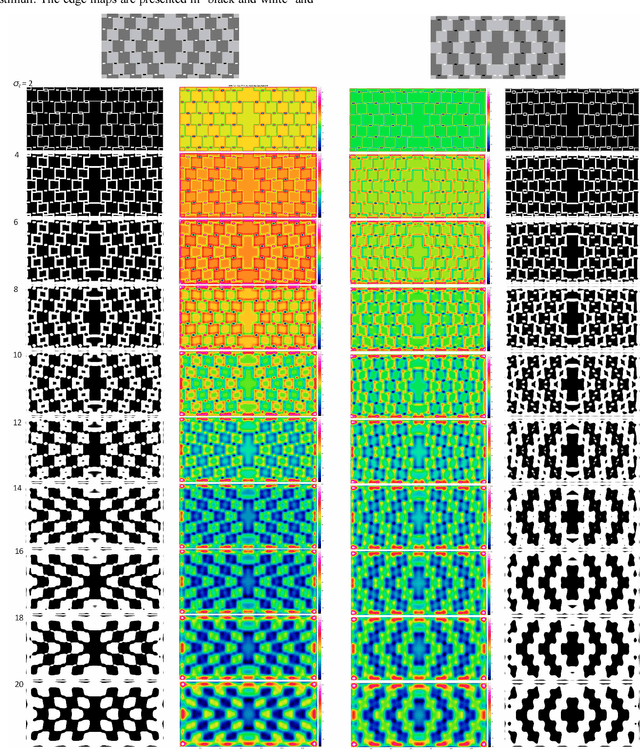
Abstract:The Caf\'e Wall illusion is one of a class of tilt illusions where lines that are parallel appear to be tilted. We demonstrate that a simple Differences of Gaussian model provides an explanatory mechanism for the illusory tilt perceived in a family of Caf\'e Wall illusion generalizes to the dashed versions of Caf\'e Wall. Our explanation models the visual mechanisms in low-level stages that can reveal tilt cues in Geometrical distortion illusions such as Tile illusions particularly Caf\'e Wall illusions. For this, we simulate the activation of the retinal/cortical simple cells in responses to these patterns based on a Classical Receptive Field (CRF) model to explain tilt effects in these illusions. Previously, it was assumed that all these visual experiences of tilt arise from the orientation selectivity properties described for more complex cortical cells. An estimation of an overall tilt angle perceived in these illusions is based on the integration of the local tilts detected by simple cells which is presumed to be a key mechanism utilized by the complex cells to create our final perception of tilt.
Informing Computer Vision with Optical Illusions
Feb 08, 2019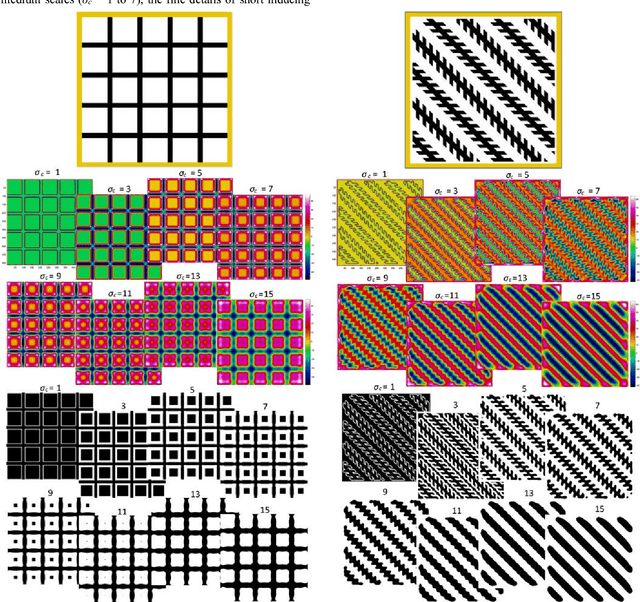
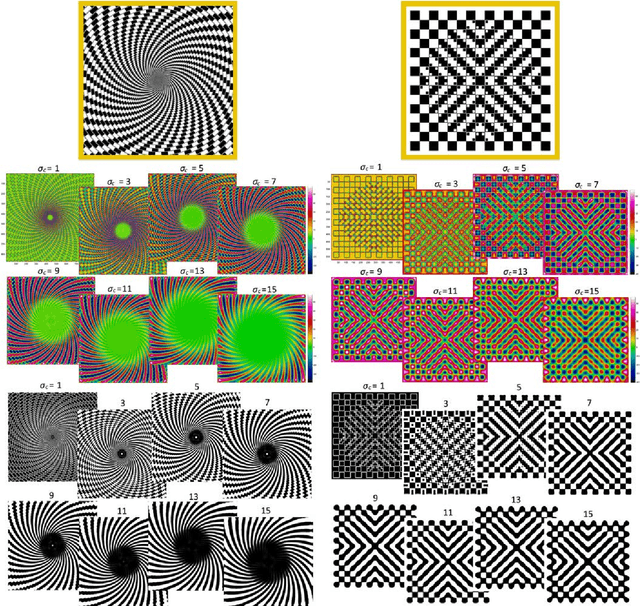
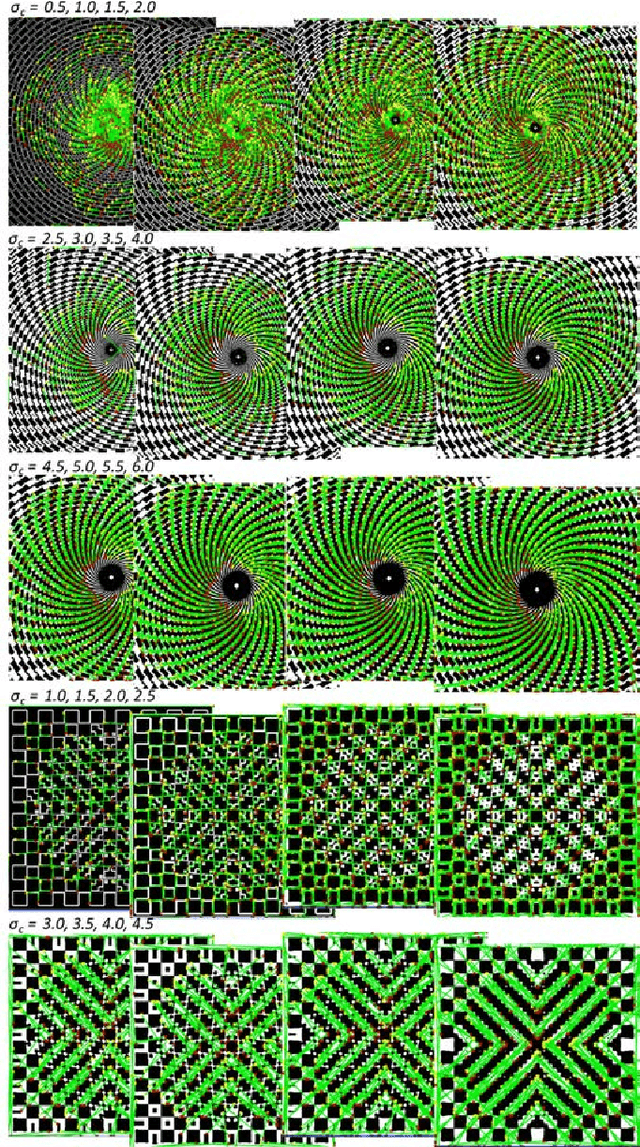

Abstract:Illusions are fascinating and immediately catch people's attention and interest, but they are also valuable in terms of giving us insights into human cognition and perception. A good theory of human perception should be able to explain the illusion, and a correct theory will actually give quantifiable results. We investigate here the efficiency of a computational filtering model utilised for modelling the lateral inhibition of retinal ganglion cells and their responses to a range of Geometric Illusions using isotropic Differences of Gaussian filters. This study explores the way in which illusions have been explained and shows how a simple standard model of vision based on classical receptive fields can predict the existence of these illusions as well as the degree of effect. A fundamental contribution of this work is to link bottom-up processes to higher level perception and cognition consistent with Marr's theory of vision and edge map representation.
A Predictive Account of Cafe Wall Illusions Using a Quantitative Model
Aug 14, 2018
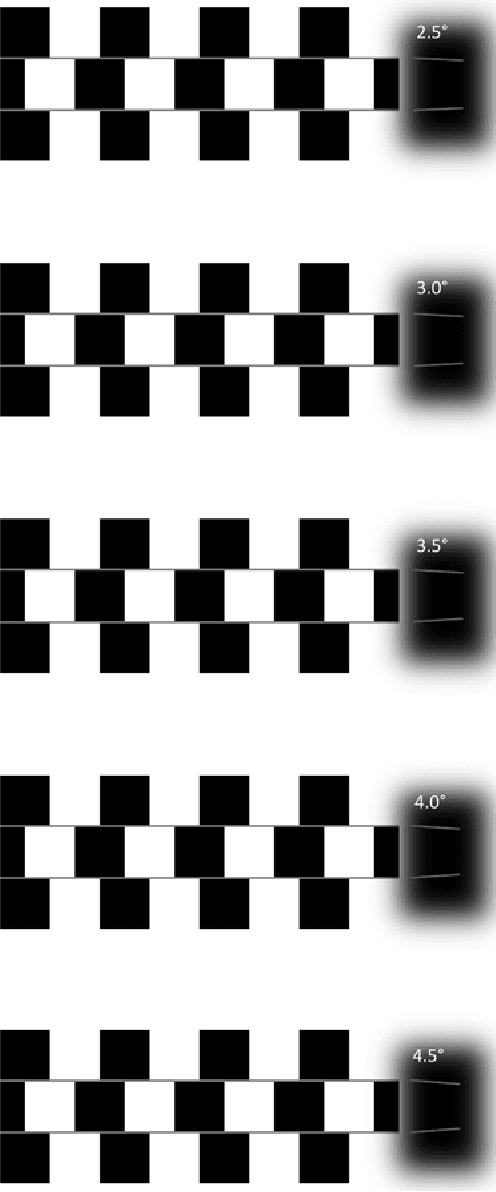
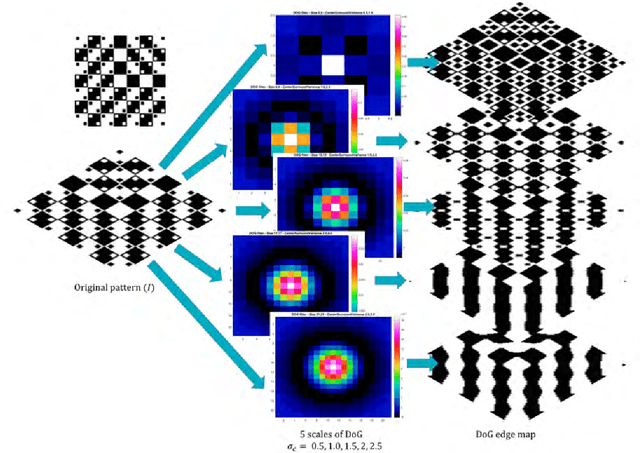
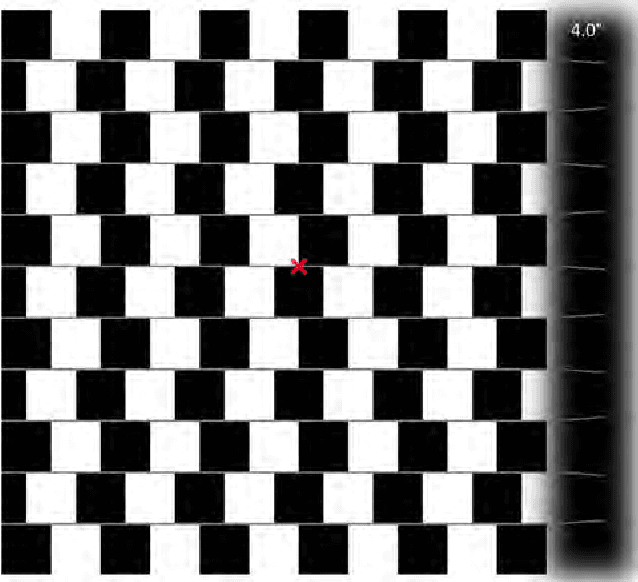
Abstract:This paper explores the tilt illusion effect in the Cafe Wall pattern using a classical Gaussian Receptive Field model. In this illusion, the mortar lines are misperceived as diverging or converging rather than horizontal. We examine the capability of a simple bioplausible filtering model to recognize different degrees of tilt effect in the Cafe Wall illusion based on different characteristics of the pattern. Our study employed a Difference of Gaussians model of retinal to cortical ON center and/or OFF center receptive fields. A wide range of parameters of the stimulus, for example mortar thickness, luminance, tiles contrast, phase of the tile displacement, have been studied. Our model constructs an edge map representation at multiple scales that reveals tilt cues and clues involved in the illusory perception of the Cafe Wall pattern. We present here that our model can not only detect the tilt in this pattern, but also can predict the strength of the illusion and quantify the degree of tilt. For the first time quantitative predictions of a model are reported for this stimulus. The results of our simulations are consistent with previous psychophysical findings across the full range of Cafe Wall variations tested. Our results also suggest that the Difference of Gaussians mechanism is the heart of the effects explained by, and the mechanisms proposed for, the Irradiation, Brightness Induction, and Bandpass Filtering models.
The Cafe Wall Illusion: Local and Global Perception from multiple scale to multiscale
Sep 17, 2017
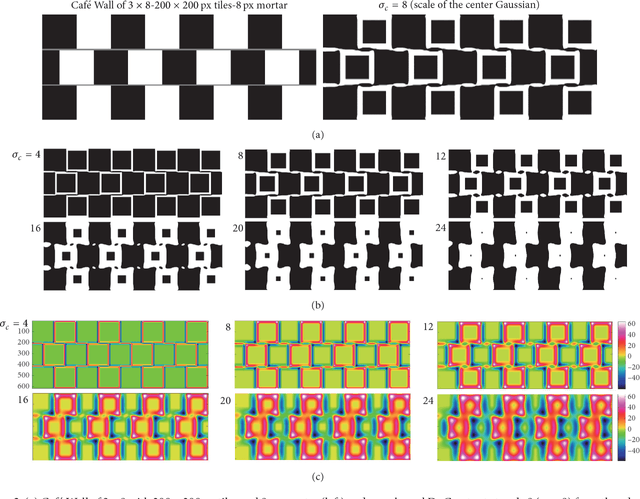


Abstract:Geometrical illusions are a subclass of optical illusions in which the geometrical characteristics of patterns such as orientations and angles are distorted and misperceived as the result of low- to high-level retinal/cortical processing. Modelling the detection of tilt in these illusions and their strengths as they are perceived is a challenging task computationally and leads to development of techniques that match with human performance. In this study, we present a predictive and quantitative approach for modeling foveal and peripheral vision in the induced tilt in Caf\'e Wall illusion in which parallel mortar lines between shifted rows of black and white tiles appear to converge and diverge. A bioderived filtering model for the responses of retinal/cortical simple cells to the stimulus using Difference of Gaussians is utilized with an analytic processing pipeline introduced in our previous studies to quantify the angle of tilt in the model. Here we have considered visual characteristics of foveal and peripheral vision in the perceived tilt in the pattern to predict different degrees of tilt in different areas of the fovea and periphery as the eye saccades to different parts of the image. The tilt analysis results from several sampling sizes and aspect ratios, modelling variant foveal views are used from our previous investigations on the local tilt, and we specifically investigate in this work, different configurations of the whole pattern modelling variant Gestalt views across multiple scales in order to provide confidence intervals around the predicted tilts. The foveal sample sets are verified and quantified using two different sampling methods. We present here a precise and quantified comparison contrasting local tilt detection in the foveal sets with a global average across all of the Caf\'e Wall configurations tested in this work.
Bioplausible multiscale filtering in retino-cortical processing as a mechanism in perceptual grouping
Sep 13, 2017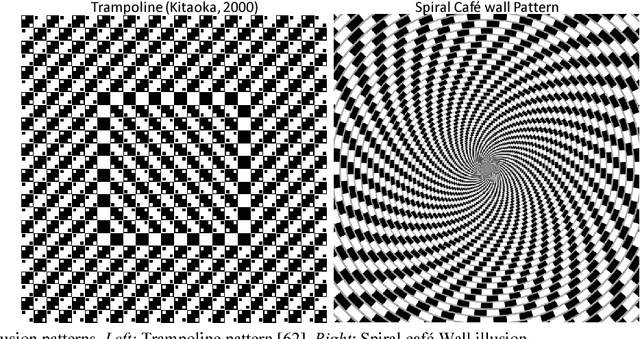


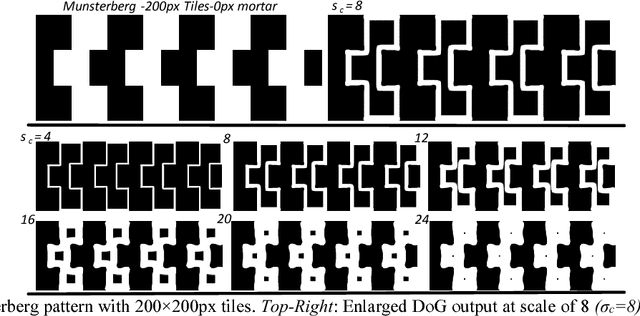
Abstract:Why does our visual system fail to reconstruct reality, when we look at certain patterns? Where do Geometrical illusions start to emerge in the visual pathway? How far should we take computational models of vision with the same visual ability to detect illusions as we do? This study addresses these questions, by focusing on a specific underlying neural mechanism involved in our visual experiences that affects our final perception. Among many types of visual illusion, Geometrical and, in particular, Tilt Illusions are rather important, being characterized by misperception of geometric patterns involving lines and tiles in combination with contrasting orientation, size or position. Over the last decade, many new neurophysiological experiments have led to new insights as to how, when and where retinal processing takes place, and the encoding nature of the retinal representation that is sent to the cortex for further processing. Based on these neurobiological discoveries, we provide computer simulation evidence from modelling retinal ganglion cells responses to some complex Tilt Illusions, suggesting that the emergence of tilt in these illusions is partially related to the interaction of multiscale visual processing performed in the retina. The output of our low-level filtering model is presented for several types of Tilt Illusion, predicting that the final tilt percept arises from multiple-scale processing of the Differences of Gaussians and the perceptual interaction of foreground and background elements. Our results suggest that this model has a high potential in revealing the underlying mechanism connecting low-level filtering approaches to mid- and high-level explanations such as Anchoring theory and Perceptual grouping.
An Integer Programming Model for Binary Knapsack Problem with Value-Related Dependencies among Elements
Feb 22, 2017Abstract:Binary Knapsack Problem (BKP) is to select a subset of an element (item) set with the highest value while keeping the total weight within the capacity of the knapsack. This paper presents an integer programming model for a variation of BKP where the value of each element may depend on selecting or ignoring other elements. Strengths of such Value-Related Dependencies are assumed to be imprecise and hard to specify. To capture this imprecision, we have proposed modeling value-related dependencies using fuzzy graphs and their algebraic structure.
Characterisation of speech diversity using self-organising maps
Jan 23, 2017
Abstract:We report investigations into speaker classification of larger quantities of unlabelled speech data using small sets of manually phonemically annotated speech. The Kohonen speech typewriter is a semi-supervised method comprised of self-organising maps (SOMs) that achieves low phoneme error rates. A SOM is a 2D array of cells that learn vector representations of the data based on neighbourhoods. In this paper, we report a method to evaluate pronunciation using multilevel SOMs with /hVd/ single syllable utterances for the study of vowels, for Australian pronunciation.
A quantitative analysis of tilt in the Café Wall illusion: a bioplausible model for foveal and peripheral vision
Sep 22, 2016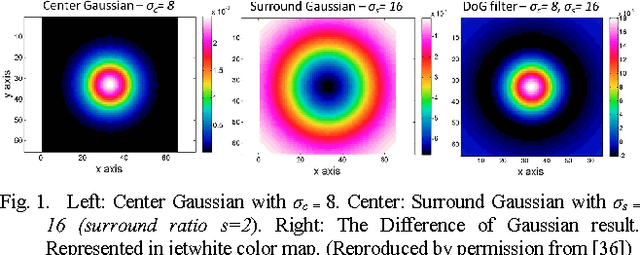
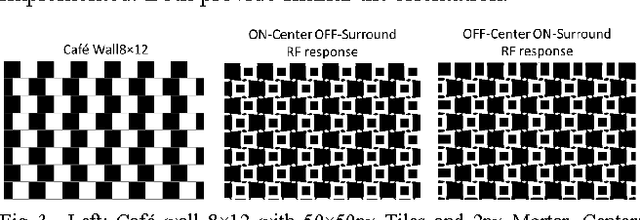


Abstract:The biological characteristics of human visual processing can be investigated through the study of optical illusions and their perception, giving rise to intuitions that may improve computer vision to match human performance. Geometric illusions are a specific subfamily in which orientations and angles are misperceived. This paper reports quantifiable predictions of the degree of tilt for a typical geometric illusion called Caf\'e Wall, in which the mortar between the tiles seems to tilt or bow. Our study employs a common bioplausible model of retinal processing and we further develop an analytic processing pipeline to quantify and thus predict the specific angle of tilt. We further study the effect of resolution and feature size in order to predict the different perceived tilts in different areas of the fovea and periphery, where resolution varies as the eye saccades to different parts of the image. In the experiments, several different minimal portions of the pattern, modeling monocular and binocular foveal views, are investigated across multiple scales, in order to quantify tilts with confidence intervals and explore the difference between local and global tilt.
 Add to Chrome
Add to Chrome Add to Firefox
Add to Firefox Add to Edge
Add to Edge